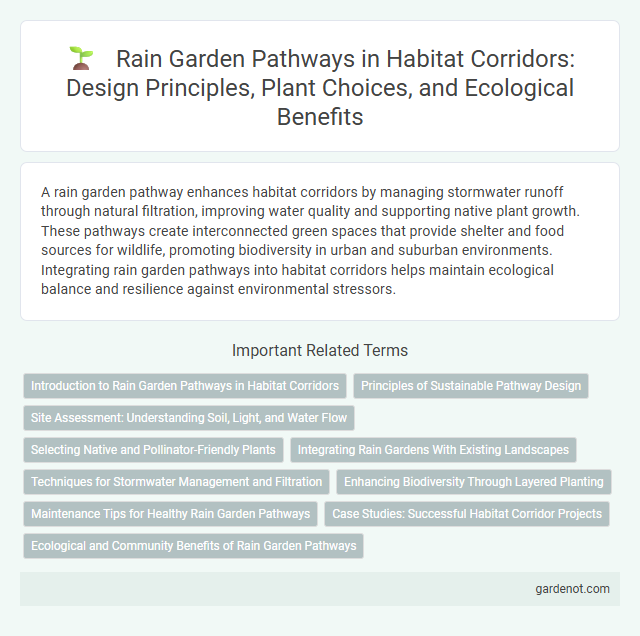A rain garden pathway enhances habitat corridors by managing stormwater runoff through natural filtration, improving water quality and supporting native plant growth. These pathways create interconnected green spaces that provide shelter and food sources for wildlife, promoting biodiversity in urban and suburban environments. Integrating rain garden pathways into habitat corridors helps maintain ecological balance and resilience against environmental stressors.
Introduction to Rain Garden Pathways in Habitat Corridors
Rain garden pathways in habitat corridors serve as sustainable landscaping features that manage stormwater runoff while enhancing biodiversity. These pathways facilitate water infiltration, reduce erosion, and support native vegetation crucial for wildlife movement and habitat connectivity. Integrating rain gardens into corridors improves ecological resilience by creating microhabitats that sustain pollinators, amphibians, and other local species.
Principles of Sustainable Pathway Design
Rain garden pathways integrate sustainable pathway design principles by utilizing permeable surfaces that enhance stormwater infiltration and reduce runoff pollution. Native vegetation in the garden supports biodiversity and provides habitat corridors for local wildlife, promoting ecological connectivity. Strategic placement and natural grading ensure minimal soil disruption and long-term durability, aligning with environmental stewardship goals.
Site Assessment: Understanding Soil, Light, and Water Flow
Site assessment for a rain garden pathway involves analyzing soil texture, permeability, and nutrient content to ensure optimal water absorption and plant growth. Evaluating sunlight exposure helps determine suitable native plant species that thrive in specific light conditions along the corridor. Understanding water flow patterns and drainage areas is critical to prevent erosion and manage stormwater effectively within the habitat corridor.
Selecting Native and Pollinator-Friendly Plants
Selecting native and pollinator-friendly plants for a rain garden pathway enhances biodiversity by providing essential habitats for local wildlife and supporting pollinator populations. Native species are adapted to regional climate and soil conditions, ensuring better growth and water absorption, which reduces runoff and improves water quality. Incorporating flowering plants like milkweed, coneflowers, and bee balm attracts bees, butterflies, and hummingbirds, creating a vibrant ecosystem corridor that promotes ecological connectivity.
Integrating Rain Gardens With Existing Landscapes
Rain garden pathways enhance habitat corridors by effectively managing stormwater runoff and improving local biodiversity through native plant selections. Integrating rain gardens with existing landscapes requires careful assessment of soil conditions, slope, and hydrology to ensure optimal water infiltration and plant health. This sustainable approach supports urban ecosystem connectivity while reducing erosion and filtering pollutants within the habitat corridor.
Techniques for Stormwater Management and Filtration
Rain garden pathways utilize biofiltration techniques to manage stormwater by directing runoff through native vegetation and porous soil layers that absorb and filter pollutants. These pathways reduce surface water flow, promote groundwater recharge, and mitigate erosion, enhancing urban habitat corridors with sustainable water management. Incorporating rain gardens in corridor design improves water quality while supporting biodiversity and resilient green infrastructure.
Enhancing Biodiversity Through Layered Planting
Rain garden pathways enhance biodiversity by incorporating layered planting that mimics natural habitats, supporting diverse flora and fauna. Deep-rooted native plants improve soil health and water filtration, while flowering shrubs and groundcovers provide food and shelter for pollinators and small wildlife. This multi-tiered vegetation structure creates a dynamic habitat corridor, promoting ecological connectivity and resilience.
Maintenance Tips for Healthy Rain Garden Pathways
Regularly removing debris and dead plant material prevents clogging and promotes water infiltration in rain garden pathways. Inspecting drainage and soil moisture ensures proper function and reduces erosion risks. Applying mulch annually helps retain moisture, suppress weeds, and stabilize pathway edges for a healthy, sustainable habitat corridor.
Case Studies: Successful Habitat Corridor Projects
Rain garden pathways have been integral to successful habitat corridor projects such as the New York City Green Infrastructure Plan, which reduced urban runoff by 30% while enhancing pollinator habitats. The Portland Green Streets Program demonstrated that integrating rain gardens in pathway designs improved stormwater management and supported native plant biodiversity. These case studies highlight how strategic implementation of rain garden pathways fosters ecological connectivity and urban resilience.
Ecological and Community Benefits of Rain Garden Pathways
Rain garden pathways enhance urban ecology by filtering stormwater, reducing runoff, and promoting groundwater recharge while providing vital habitats for pollinators and local wildlife. These permeable landscapes contribute to biodiversity by supporting native plants and creating continuous green corridors that connect fragmented habitats. Community benefits include improved air quality, aesthetic appeal, and educational opportunities for residents to engage with sustainable environmental practices.
Rain garden pathway Infographic

 gardenot.com
gardenot.com